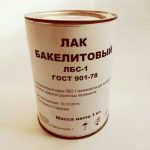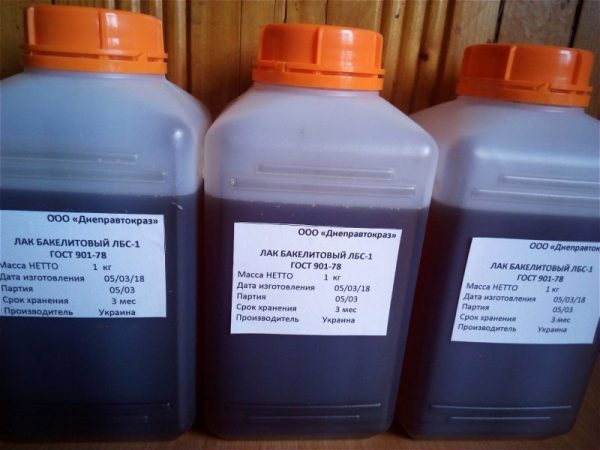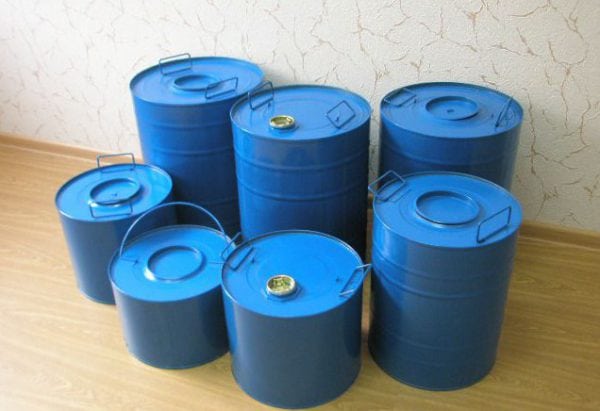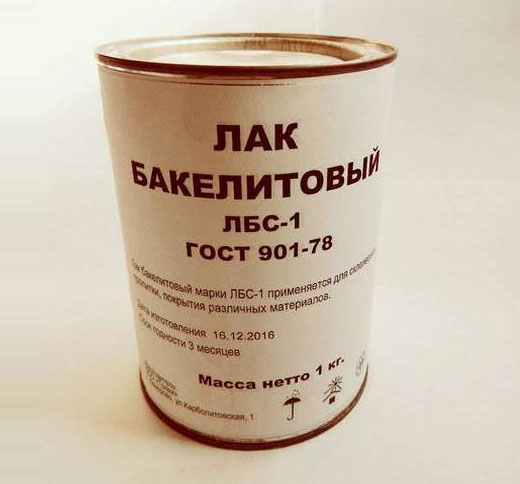Bakelite varnish LBS-1 consists of a solution of resol resaldehyde resin. Ethyl alcohol is used here as a solvent. In addition, ammonia is added to this composition, which acts as a catalyst for the chemical reaction. This substance also gives the varnish a specific smell.
- Technical characteristics of LBS-1
- The use of bakelite paint and varnish composition
- Preparatory stage
- Application Rules
- Chemical equipment protection

Varnish LBS-1 is intended for:
- joining, coating and impregnating surfaces;
- ensuring protection of devices involved in heat transfer from the negative influence of hot process fluid;
- protection of various devices from exposure to moderate acid and salt solutions;
- painting tanks with gasoline and oil tanks;
- creating binders used in the production of layered plastic with mineral organic fillers;
- production of abrasive tools, chemical fibers;
- protection of pipelines and air drying filters from the effects of environmental corrosion;
- protective coating varnishing;
- protection of surfaces made of wood and concrete;
- chemical engineering production.
Technical characteristics of LBS-1
| Characteristic | Indicators |
|---|---|
| External parameters | transparent composition, may be red or dark red. It does not contain suspended particles of other substances |
| Resin content | from 50 to 60% |
| Dynamic type viscosity | 100 to 900 MPa-s |
| The content of free phenol components in the solution | 9 % |
| Gelatinization time | from 1 to 2 minutes |
| Water content | 10 % |
to contents ↑
The use of bakelite paint and varnish composition
Most often, this paint material is used to protect chemical devices and their components from the corrosive effects of the environment.
Preparatory stage
Immediately before work, the protective surface must be carefully treated to obtain a bakelite-based coating of the required quality. It is cleaned of dirt, particles of rust, dust, scale and grease with a bead-blasting or sandblasting machine until a gray color with a matte finish appears. Next, prepare the solution itself.
First you need to shake the jar with varnish and mix its contents. If the varnish contains up to 40% filler, such as diabase powder, graphite or kaolin, it can be used as a primer. Specialists apply this layer with a paint brush, applying a small force to rub the soil into the surface of the metal structure, but no later than three hours after its processing. Thus, they eliminate the possibility of rust on the metal coating.
to contents ↑Application Rules
Then the first layer is dried under natural conditions for 4 hours and carry out its polymerization. After that, the working surface is primed and covered with a second layer of bakelite type varnish, which consists of 25% filler. The next step is the polymerization of the second layer.Then apply the third and fourth coat of paint material already without filler. The thickness of the varnish surface should not exceed 0.5 mm.
Throughout all the work, the varnish is applied only with a brush, and if a large surface area is painted, then a spray gun can be used. But at the same time, you need to make sure that the varnish lays in thin layers without gaps and sagging throughout the coating.
In order for the bakelite coating to be mechanically strong, it is necessary to glue 2-3 layers of cotton fabric onto the surface on which the soil was previously applied. Initially, the fabric is impregnated in a bakelite paint and varnish material, and then it is glued as follows.
The fabric is cleaned of starch, washed, dried and cut into blanks of the desired diameter, and then placed in a container with a 25% solution of bakelite type varnish. After 5-6 minutes, the material is removed, twisted by hands, wearing rubber gloves, since the varnish has an irritating and burning effect on the skin. Then it is dried in the open air until the solvent is completely removed. The fabric in the state of tack is glued to the primed metal structure.
However, when conducting this procedure, you need to ensure that the material does not stretch. If this happens, then the fabric may rupture during drying due to shrinkage. At the final stage, the cotton fabric is dyed with a brush moistened with bakelite varnish, making a slight pressure.
to contents ↑Chemical equipment protection
To protect parts of chemical equipment, for example, stirrers or coils, impregnated with bakelite paint and varnish, the fabric must be cut into strips and wound tightly on the surfaces to be protected, making 30-40 mm overlap of the edges of the banding.
The number of wound layers of fabric is determined by each project individually. When all layers are wound, it is necessary to apply a coating layer of varnish to the surface of the fabric. After that, each individual coating layer should be subjected to heat treatment, during which curing of bakelite varnish takes place.
After performing heat treatment, you must adhere to certain rules. So, the apparatus on which the bakelite paintwork was applied is cooled for 6-8 hours at a temperature of 20-30 ° C. If the heat treatment was correctly observed, the surface of the varnish film should be smooth and shiny. Also, it should acquire a brown-red color.
Thermal procedures can be carried out poorly, as a result of which the following negative points can be observed. So, the surface covered with bakelite varnish and cooled at a temperature of 70–80 ° C is cleaned with a rag soaked in ethanol, and if a yellow-brown stain remains on the rag, this indicates poor heat treatment.
Thus, bakelite varnish is an effective paint and varnish material with a wide scope. In order to make maximum use of the positive qualities of the composition, it is necessary to follow the rules for its application, adjusting them in each specific situation.








Tell me, can I paint the wooden floor in rabbit cages with bakelite varnish to protect them from chewing?
In no case. Contains phenol (poison) and formaldehyde (poison). Will you eat phenol-formaldehyde meat - do you need it ?!
Tell me, if bakelite varnish has got on the skin, how to remove it?
Please tell me its operating temperature and whether it can be used in internal combustion engines. Thanks.
Please tell me, bakelite varnish LBS-1 and bakelite varnish LBS-2 hardened. Is it possible to dissolve and use something, or is it all, recycling? Year of release April 2016.